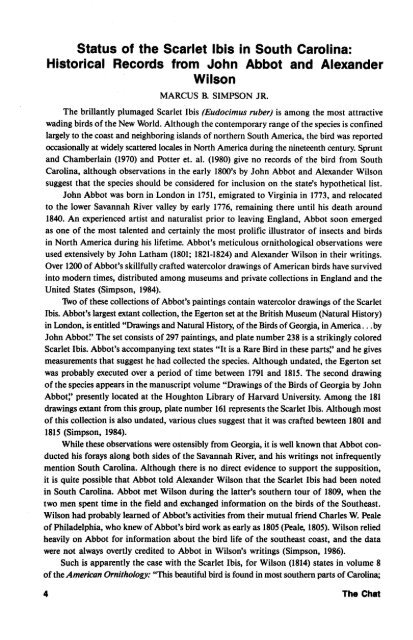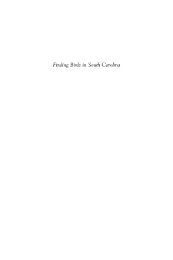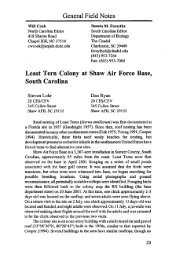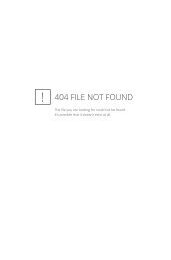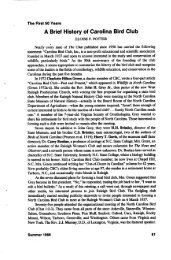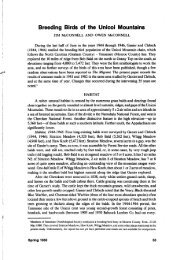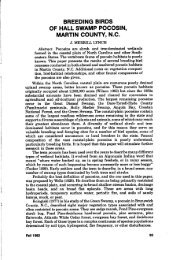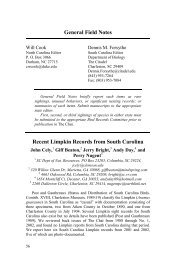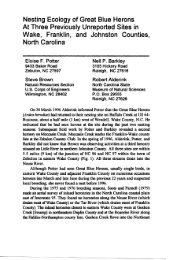Status of the Scarlet Ibis in South Carolina - The Carolina Bird Club
Status of the Scarlet Ibis in South Carolina - The Carolina Bird Club
Status of the Scarlet Ibis in South Carolina - The Carolina Bird Club
Create successful ePaper yourself
Turn your PDF publications into a flip-book with our unique Google optimized e-Paper software.
<strong>Status</strong> <strong>of</strong> <strong>the</strong> <strong>Scarlet</strong> <strong>Ibis</strong> <strong>in</strong> <strong>South</strong> Carol<strong>in</strong>a:Historical Records from John Abbot and AlexanderWilsonMARCUS B. SIMPSON JR.<strong>The</strong> brillantly plumaged <strong>Scarlet</strong> <strong>Ibis</strong> (Eudocimus ruber) is among <strong>the</strong> most attractivewad<strong>in</strong>g birds <strong>of</strong> <strong>the</strong> New World. Although <strong>the</strong> contemporary range <strong>of</strong> <strong>the</strong> species is conf<strong>in</strong>edlargely to <strong>the</strong> coast and neighbor<strong>in</strong>g islands <strong>of</strong> nor<strong>the</strong>rn <strong>South</strong> America, <strong>the</strong> bird was reportedoccasionally at widely scattered locales <strong>in</strong> North America dur<strong>in</strong>g <strong>the</strong> n<strong>in</strong>eteenth century. Spruntand Chamberla<strong>in</strong> (1970) and Potter et. al. (1980) give no records <strong>of</strong> <strong>the</strong> bird from <strong>South</strong>Carol<strong>in</strong>a, although observations <strong>in</strong> <strong>the</strong> early 1800's by John Abbot and Alexander Wilsonsuggest that <strong>the</strong> species should be considered for <strong>in</strong>clusion on <strong>the</strong> state's hypo<strong>the</strong>tical list.John Abbot was born <strong>in</strong> London <strong>in</strong> 1751, emigrated to Virg<strong>in</strong>ia <strong>in</strong> 1773, and relocatedto <strong>the</strong> lower Savannah River valley by early 1776, rema<strong>in</strong><strong>in</strong>g <strong>the</strong>re until his death around1840. An experienced artist and naturalist prior to leav<strong>in</strong>g England, Abbot soon emergedas one <strong>of</strong> <strong>the</strong> most talented and certa<strong>in</strong>ly <strong>the</strong> most prolific illustrator <strong>of</strong> <strong>in</strong>sects and birds<strong>in</strong> North America dur<strong>in</strong>g his lifetime. Abbot's meticulous ornithological observations wereused extensively by John Latham (1801; 1821-1824) and Alexander Wilson <strong>in</strong> <strong>the</strong>ir writ<strong>in</strong>gs.Over 1200 <strong>of</strong> Abbot's skillfully crafted watercolor draw<strong>in</strong>gs <strong>of</strong> American birds have survived<strong>in</strong>to modern times, distributed among museums and private collections <strong>in</strong> England and <strong>the</strong>United States (Simpson, 1984).Two <strong>of</strong> <strong>the</strong>se collections <strong>of</strong> Abbot's pa<strong>in</strong>t<strong>in</strong>gs conta<strong>in</strong> watercolor draw<strong>in</strong>gs <strong>of</strong> <strong>the</strong> <strong>Scarlet</strong><strong>Ibis</strong>. Abbot's largest extant collection, <strong>the</strong> Egerton set at <strong>the</strong> British Museum (Natural History)<strong>in</strong> London, is entitled "Draw<strong>in</strong>gs and Natural History, <strong>of</strong> <strong>the</strong> <strong>Bird</strong>s <strong>of</strong> Georgia, <strong>in</strong> America . . . byJohn Abbot." <strong>The</strong> set consists <strong>of</strong> 297 pa<strong>in</strong>t<strong>in</strong>gs, and plate number 238 is a strik<strong>in</strong>gly colored<strong>Scarlet</strong> <strong>Ibis</strong>. Abbot's accompany<strong>in</strong>g text states "It is a Rare <strong>Bird</strong> <strong>in</strong> <strong>the</strong>se parts,' and he givesmeasurements that suggest he had collected <strong>the</strong> species. Although undated, <strong>the</strong> Egerton setwas probably executed over a period <strong>of</strong> time between 1791 and 1815. <strong>The</strong> second draw<strong>in</strong>g<strong>of</strong> <strong>the</strong> species appears <strong>in</strong> <strong>the</strong> manuscript volume "Draw<strong>in</strong>gs <strong>of</strong> <strong>the</strong> <strong>Bird</strong>s <strong>of</strong> Georgia by JohnAbbot," presently located at <strong>the</strong> Houghton Library <strong>of</strong> Harvard University. Among <strong>the</strong> 181draw<strong>in</strong>gs extant from this group, plate number 161 represents <strong>the</strong> <strong>Scarlet</strong> <strong>Ibis</strong>. Although most<strong>of</strong> this collection is also undated, various clues suggest that it was crafted bewteen 1801 and1815 (Simpson, 1984).While <strong>the</strong>se observations were ostensibly from Georgia, it is well known that Abbot conductedhis forays along both sides <strong>of</strong> <strong>the</strong> Savannah River, and his writ<strong>in</strong>gs not <strong>in</strong>frequentlymention <strong>South</strong> Carol<strong>in</strong>a. Although <strong>the</strong>re is no direct evidence to support <strong>the</strong> supposition,it is quite possible that Abbot told Alexander Wilson that <strong>the</strong> <strong>Scarlet</strong> <strong>Ibis</strong> had been noted<strong>in</strong> <strong>South</strong> Carol<strong>in</strong>a. Abbot met Wilson dur<strong>in</strong>g <strong>the</strong> latter's sou<strong>the</strong>rn tour <strong>of</strong> 1809, when <strong>the</strong>two men spent time <strong>in</strong> <strong>the</strong> field and exchanged <strong>in</strong>formation on <strong>the</strong> birds <strong>of</strong> <strong>the</strong> Sou<strong>the</strong>ast.Wilson had probably learned <strong>of</strong> Abbot's activities from <strong>the</strong>ir mutual friend Charles W. Peale<strong>of</strong> Philadelphia, who knew <strong>of</strong> Abbot's bird work as early as 1805 (Peale, 1805). Wilson reliedheavily on Abbot for <strong>in</strong>formation about <strong>the</strong> bird life <strong>of</strong> <strong>the</strong> sou<strong>the</strong>ast coast, and <strong>the</strong> datawere not always overtly credited to Abbot <strong>in</strong> Wilson's writ<strong>in</strong>gs (Simpson, 1986).Such is apparently <strong>the</strong> case with <strong>the</strong> <strong>Scarlet</strong> <strong>Ibis</strong>, for Wilson (1814) states <strong>in</strong> volume 8<strong>of</strong> <strong>the</strong> American Ornithology: "This beautiful bird is found <strong>in</strong> most sou<strong>the</strong>rn parts <strong>of</strong> Carol<strong>in</strong>a;4 <strong>The</strong> Chat
also <strong>in</strong> Georgia and Florida." Subsequent editions <strong>of</strong> Wilson's Ornithologyrepeated <strong>the</strong> assertion,which was occasionally duplicated by later writers until <strong>the</strong> claim eventually disappearedfrom <strong>the</strong> ornithological literature by <strong>the</strong> end <strong>of</strong> <strong>the</strong> century. Abbot's British correspondent,John Latham, mentioned <strong>in</strong> volume IX <strong>of</strong> <strong>the</strong> General History <strong>of</strong> <strong>Bird</strong>s (1824) that "a few(were) seen <strong>in</strong> <strong>the</strong> <strong>South</strong> <strong>of</strong> Carol<strong>in</strong>a, and sometimes <strong>in</strong> Georgia," but it is not apparent whe<strong>the</strong>rhe was paraphras<strong>in</strong>g Wilson or quot<strong>in</strong>g directly from Abbot. Although Wilson might haveobta<strong>in</strong>ed this <strong>in</strong>formation elsewhere, it seems most likely that his <strong>in</strong>formant was Abbot, whocrafted at least two watercolor render<strong>in</strong>gs <strong>of</strong> <strong>the</strong> bird. Due to <strong>the</strong> absence <strong>of</strong> specimens andlack <strong>of</strong> detailed records, Wilson's claim that <strong>the</strong> <strong>Scarlet</strong> <strong>Ibis</strong> occured <strong>in</strong> <strong>the</strong> "most sou<strong>the</strong>rnparts <strong>of</strong> Carol<strong>in</strong>a" should prompt consideration <strong>of</strong> admitt<strong>in</strong>g <strong>the</strong> species to <strong>the</strong> hypo<strong>the</strong>ticallist for <strong>South</strong> Carol<strong>in</strong>a.LITERATURE CITEDLatham, John. 1801. Supplement II to <strong>the</strong> General Synposis <strong>of</strong> <strong>Bird</strong>s. London, Leigh, So<strong>the</strong>by& Son.Latham, John. 1821-1824. General History <strong>of</strong> <strong>Bird</strong>s. W<strong>in</strong>chester, Jacob and Johnson. 10volumes.Peale, C.W. 1805. Letter to Raphael Peale, 11 July 1805, manuscript (Wash<strong>in</strong>gton: Peale FamilyPapers, Archives, National Portrait Gallery)Potter, E.F., J.F. Parnell & R.P. Teul<strong>in</strong>gs. 1980. <strong>Bird</strong>s <strong>of</strong> <strong>the</strong> Carol<strong>in</strong>as. Chapel Hill,University <strong>of</strong> North Carol<strong>in</strong>a Press, 408 pp.Simpson, M.B. 1984. <strong>The</strong> Artist-Naturalist John Abbot (1751-ca 1840): Contributions to <strong>the</strong>Ornithology <strong>of</strong> <strong>the</strong> <strong>South</strong> United States. North Carol<strong>in</strong>a HistoricalReview 61:347-390.Simpson, M.B. and D.S. McAllister. 1986. Alexander Wilson's Sou<strong>the</strong>rn Tour <strong>of</strong> 1809: <strong>The</strong>North Carol<strong>in</strong>a Transit and Subscribers to <strong>the</strong> American Ornithology. North Carol<strong>in</strong>aHistorical Review 63:421-476.Sprunt, A., Jr. and E.B. Chamberla<strong>in</strong>. 1970. <strong>South</strong> Carol<strong>in</strong>a <strong>Bird</strong> Life. Columbia,University <strong>of</strong> <strong>South</strong> Carol<strong>in</strong>a Press.Wilson, Alexander. 1814. American Ornithology. Philadelphia, Bradford and Inskeep.Vol. 8, p. 81.11905 Yellow Rush Pass, Columbia, MD 21044.WINTER 1988 5


